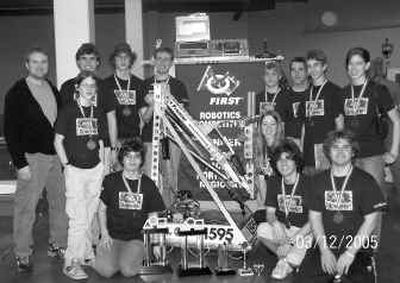St. George’s robot – and team – in national competition

He’s about 10 feet tall, and he and his teammates are heading to a national tournament.
He’s known as No. 1595, and he’s a robot constructed and controlled by the student Robotic Club at St. George’s School.
On March 12, he won the FIRST (For Inspiration and Recognition of Science and Technology) Robotics’ Northwest regional competition in Portland.
The competition included teams from 37 high schools, including teams from California, Montana and Alaska. The St. George’s team is one of six teams heading to the national FIRST Robotics tournament in Atlanta on April 21-23.
St. George’s robot also won both of the individual awards at the regional competition. It was named Best Design by the other 36 teams at the regional competition and also won the Judge’s Award for the most successful machine after ranking first in all categories measured.
“We crushed the competition; it wasn’t even close,” said Rick DeFord, St. George’s physics teacher and Robotics Club adviser. “Our alliance won the championship round by a score of 89 to 4.
“During the tournament, we racked up three of the top four scores in the country so far.”
St. George’s robot was part of an alliance of three teams that won the Northwest regionals. The competition consisted of 10 qualifying rounds.
The top point-getters were placed in alliances of three teams that competed in standard single-elimination rounds.
This was the first year that St. George’s entered the FIRST Robotics competition, financed by a $6,000 grant from NASA.
“It’s very unusual for a rookie team’s machine to win a regional competition,” DeFord said. “But teams can earn extra points if their robot can perform pre-programmed maneuvers during the first 15 seconds of each round, and our machine was the only one to earn points in all 17 rounds.”
DeFord said the competition was intense. They had a great design, but software glitches kept the students working to debug the program until just 30 minutes before the deadline.
Nearly 350 teams from 30 regional competitions will qualify for the national competition. Robot No. 1595 already has been shipped there in preparation for the competition, where machines play tic-tac-toe on a playing field more than half the size of a basketball court.
Robots score points by lifting pyramid-shaped tetrahedrons of plastic tubing with an extendable arm and placing them on top of other “goal” structures that may stand up to 7 feet high.